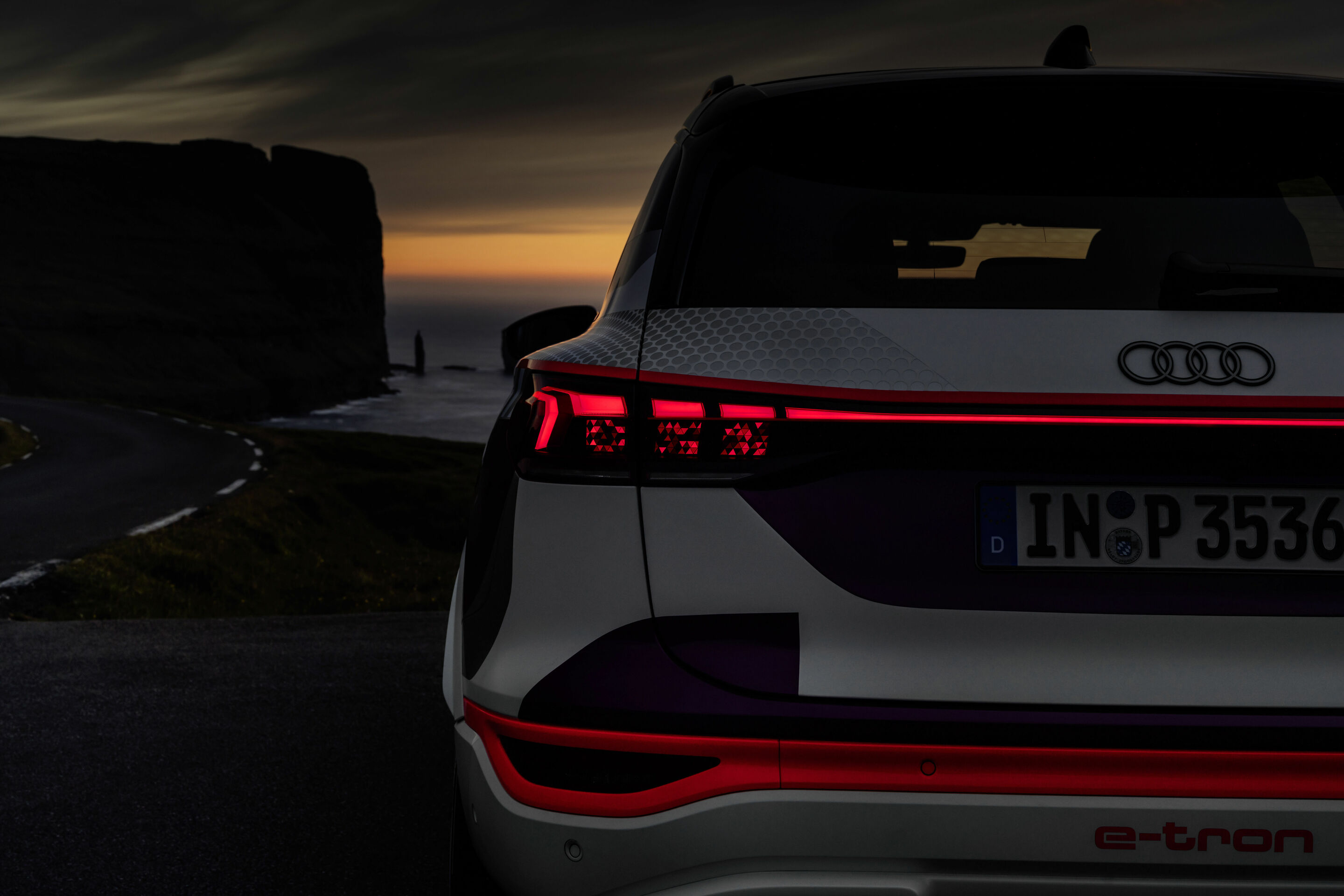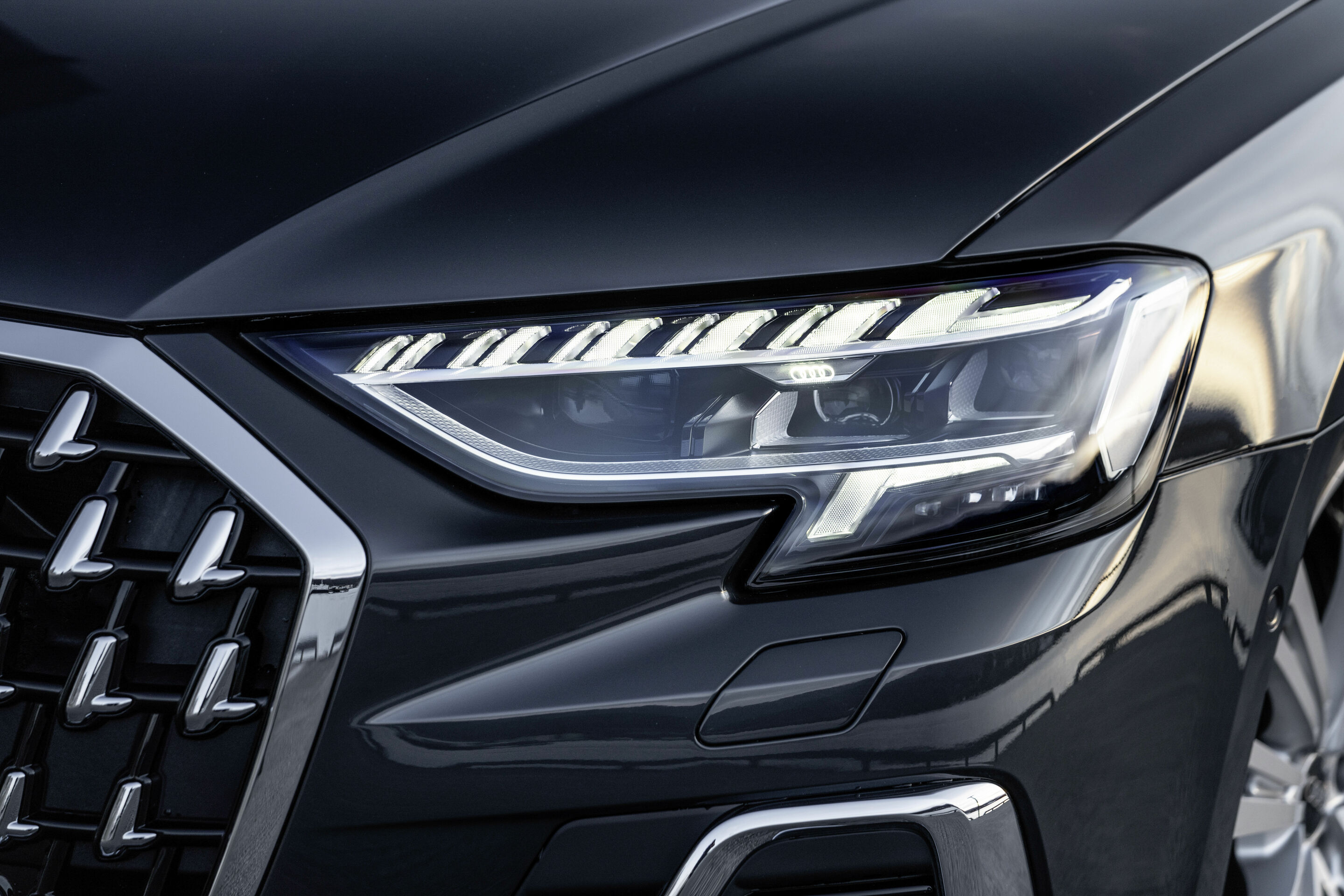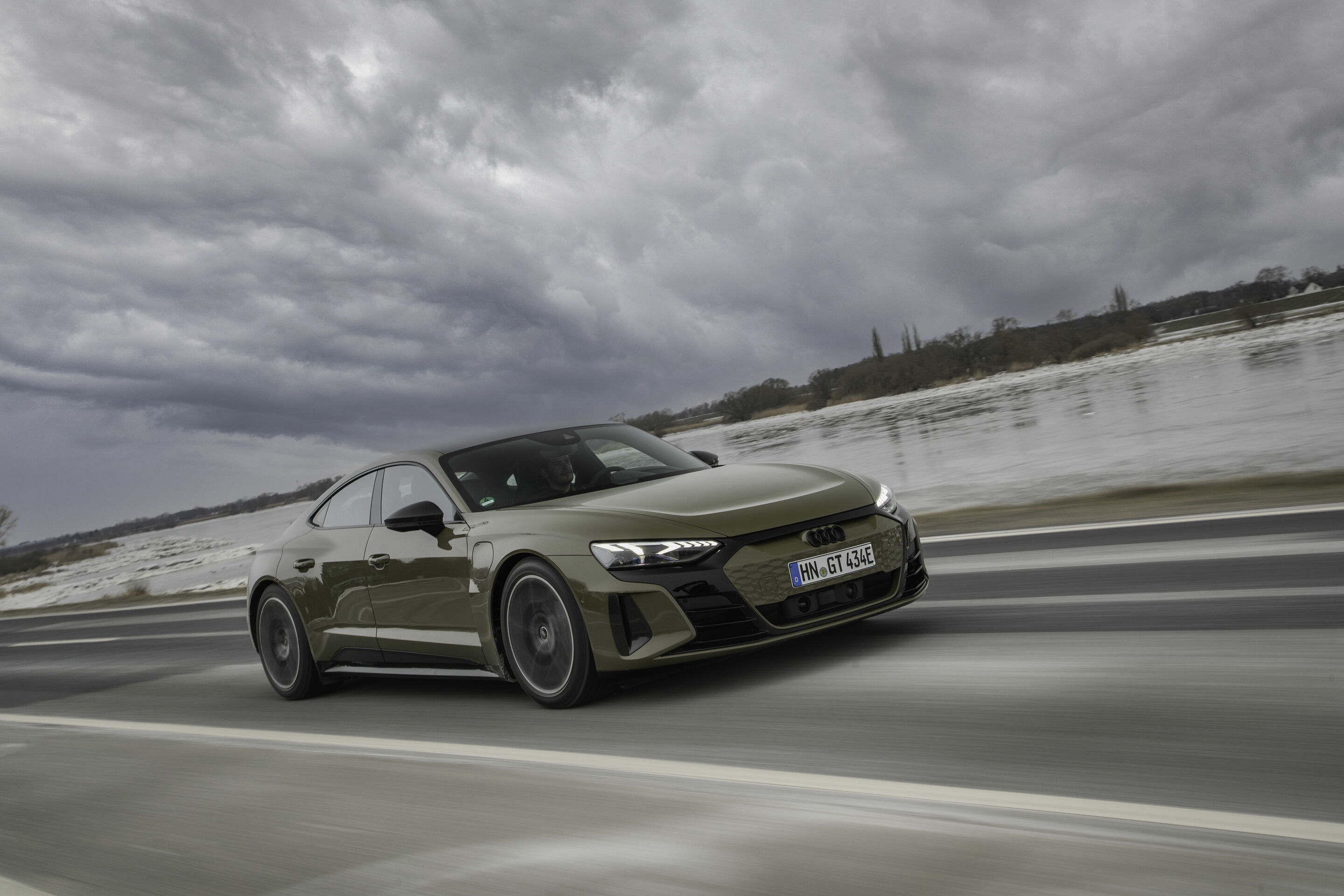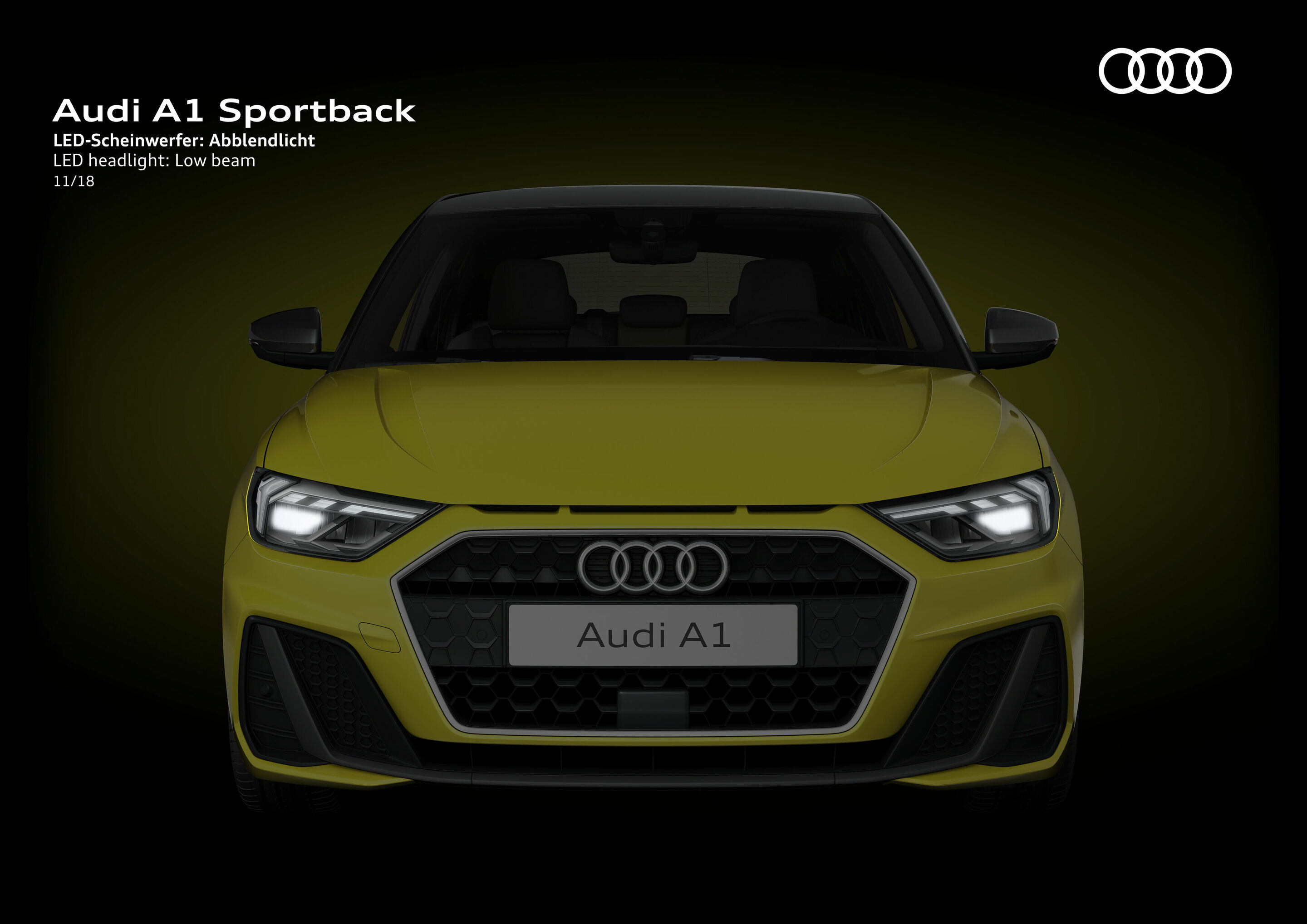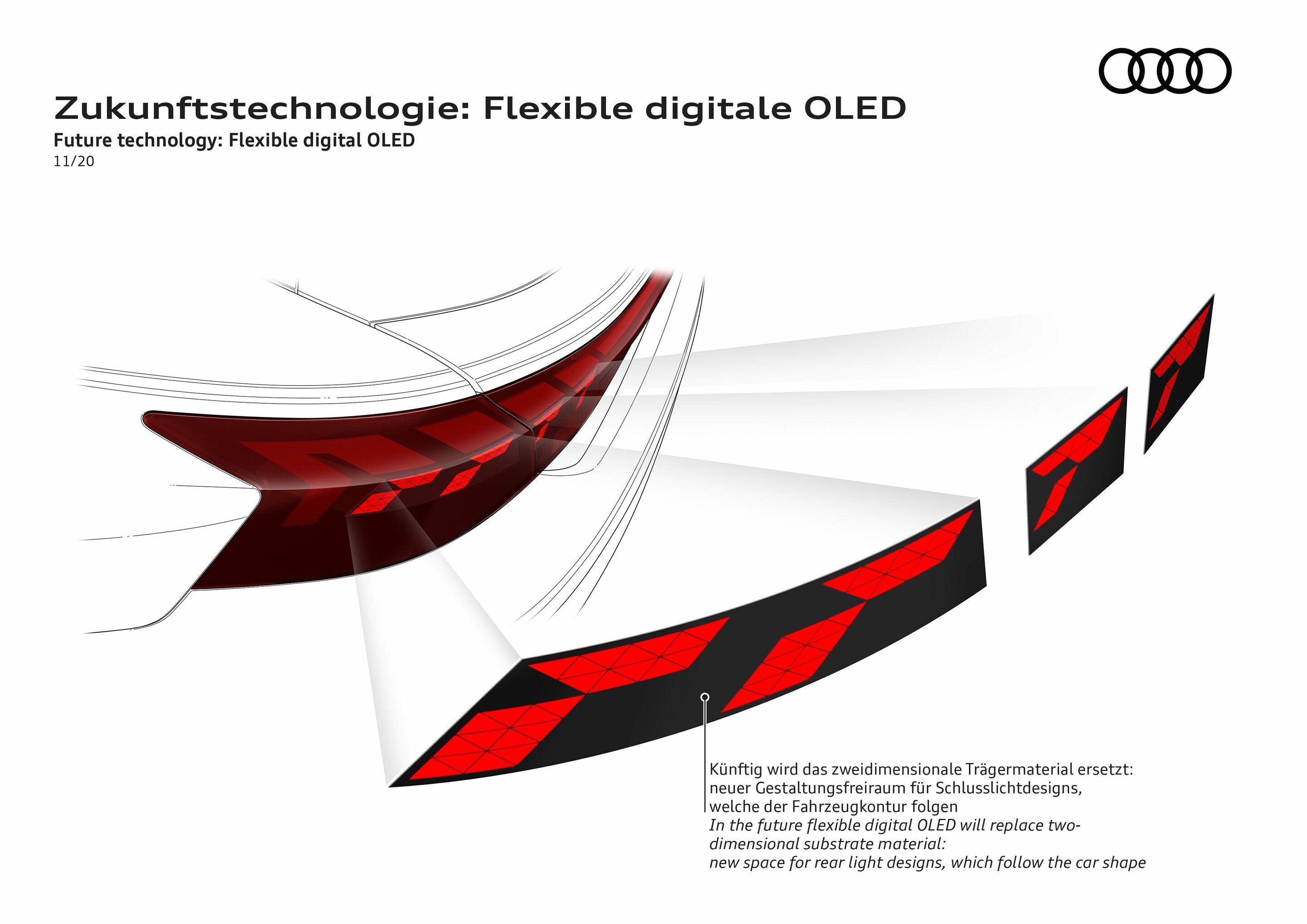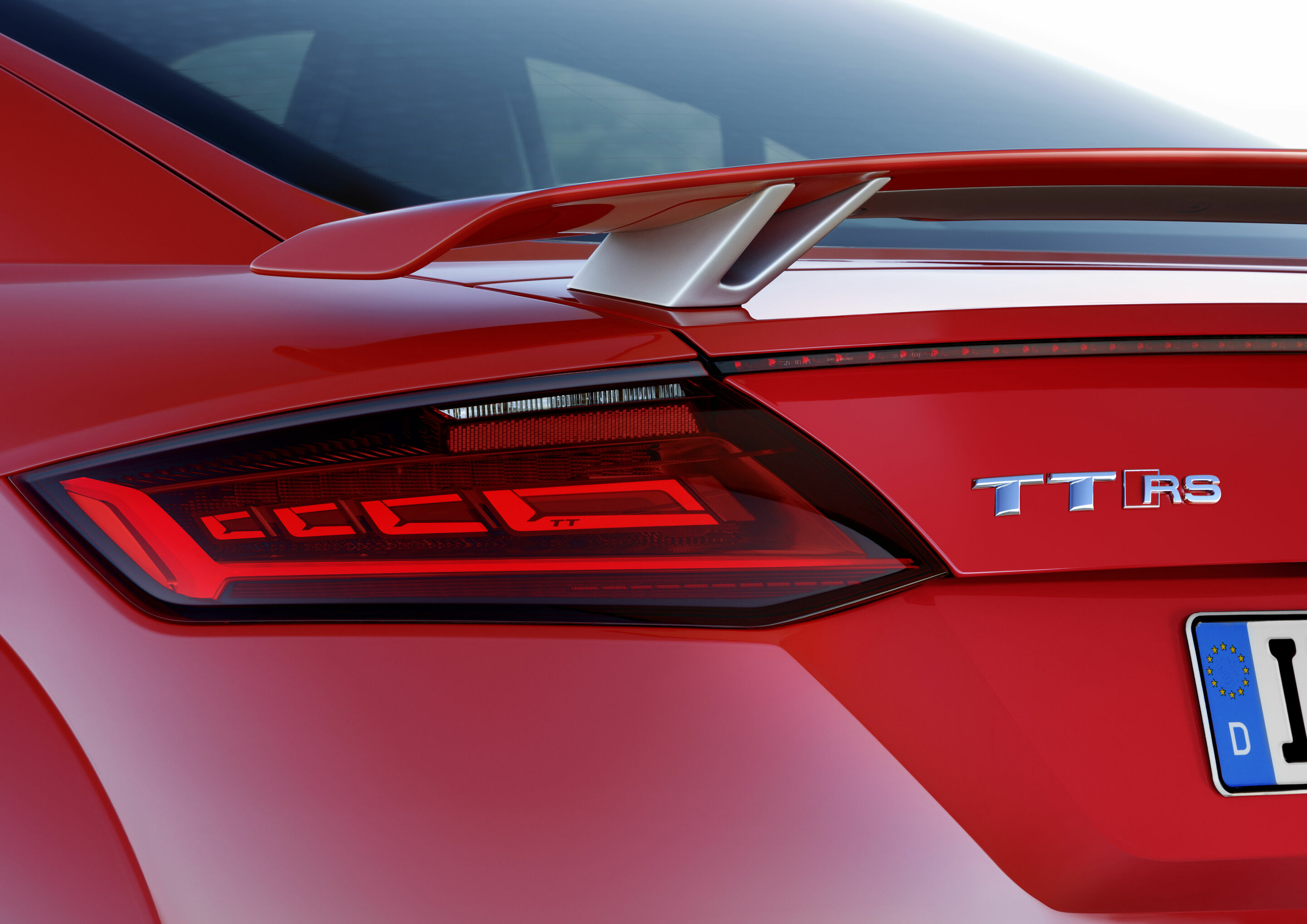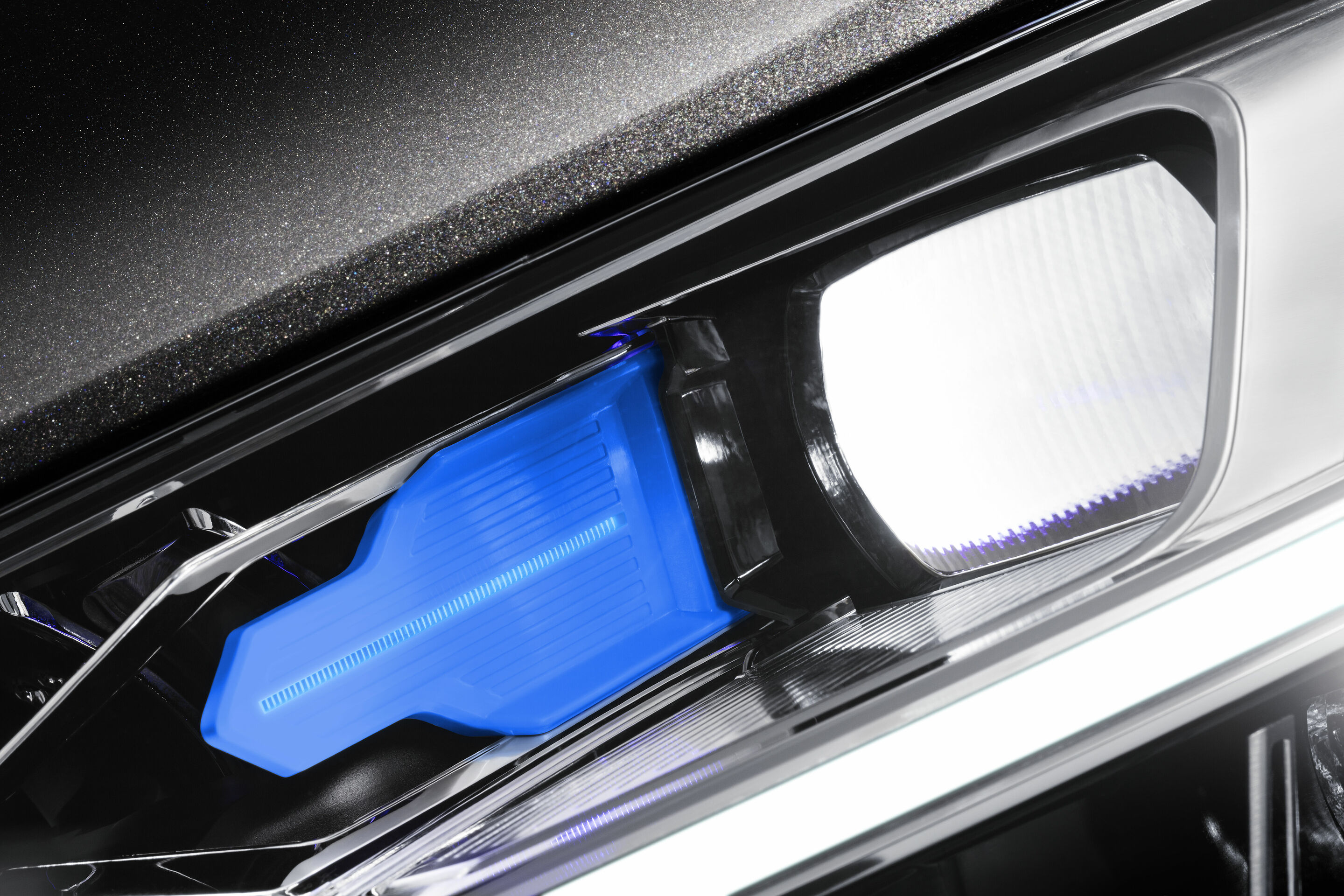Lighting
Back to overviewAudi is the world’s leading car manufacturer in the field of automotive lighting technology. The company’s lighting systems combine exceptional design with high functionality. The digitalization of light enables new lighting features, enhances safety, and drives technological progress forward. It opens up new possibilities in safety, design, and communication, while also allowing for greater personalization.
Beyond its functional role, lighting in all Audi models is a central design element. It serves as a strong visual representation of the brand’s core values – progressiveness, sportiness, and prestige.
Note: The technologies described here reflect the state of development at Audi, either as it currently stands or as it has been in the past. Not all systems mentioned are available in the current model range.
Illuminated rings
The package, including a protective housing, consists of the outer cover with the four rings, which can be ordered in white/black or dark gray/black, and protects the intermediate lighting component and the circuit board with eight LEDs behind it. The intermediate lighting component projects the LED light uniformly onto the inside of the outer cover, which is diffusely refracted several times in the transparent or dark-gray thermoplastic (PMMA) outer cover so that the light appears homogeneous to the human eye. The four rings are thus illuminated almost perfectly and blend seamlessly into the overall look with the second-generation digital OLED rear lights.
Digital matrix LED headlights (Audi A8)
The digital matrix LED headlights can display bend, city, and highway lighting with maximum precision as variants of the low beams, generating numerous adaptive light distributions through the direct projection of high-resolution light images to ensure added safety. It complements the high beams with even more precise masking of other road users.
Behind this is a technology known as DMD. That stands for Digital Micromirror Device – a chip made up of 1.3 million micromirrors that makes headlight projections possible. Using electrostatic fields, each individual micromirror can tilt up to 5,000 times per second. Depending on its position, the LED light is either directed through lenses onto the road or absorbed to create masked areas. This divides the light into tiny pixels.
This technology forms the basis for a wide range of functions, such as the lane light, orientation light, and enhanced traffic information. These innovations support and improve road safety.
On highways and country roads, the lane light creates a carpet of light that brightly illuminates the driver’s lane and dynamically adjusts during lane changes. This increases the driver’s focus on the relevant lane and contributes to overall traffic safety. The orientation light uses dark, light-excluded gradients to proactively indicate the vehicle’s position within the lane, supporting the lane centering assistant – especially useful on narrow roads and in construction zones. The marking light is also used in conjunction with the optional night vision assistant. If the system detects pedestrians, the light highlights them, reducing the risk of overlooking people near the roadway.
Additionally, the digital matrix LED headlights can generate dynamic coming/leaving home lighting scenarios, which appear as projections on a wall or on the ground. This turns the space in front of the vehicle into a purposefully illuminated stage.
When the turn signal is activated, the headlights create a dynamic flashing zone on the corresponding side of the lane light — specifically, the lane light with turn signal indication. The lane light thus reinforces the turn signal by projecting it onto the road ahead. This also provides a clear visual cue to surrounding traffic about the intended lane change. With this feature, Audi increases safety for all road users, especially in heavy traffic. The following applies to both the low beams (bend, city, and highway lighting) and the high beams: The increased precision of the light further improves safety for other road users – thanks to more accurate masking of oncoming traffic and vehicles ahead.
If potential warnings about accidents or breakdowns are displayed in the MMI system, the digital matrix LED headlights, including the DMD module, provide an additional layer of reliability. In addition to a warning displayed in the digital instrument cluster, the headlights now also project a visual alert onto the road in front of the vehicle for around three seconds. A projected triangle with an exclamation mark inside is visible from the steering wheel. This allows the driver to keep their eyes on the road and react as quickly as possible in the event of an accident or breakdown.
Digital matrix LED headlights (Audi Q3)
Audi continues to advance its lighting technology. With the new Audi Q3, the brand is launching digital matrix LED headlights featuring new micro-LED technology in the compact segment. The new micro-LED technology replaces the previously known DMD technology in the digital matrix LED headlights. Advantages of the new micro-LED technology: smaller installation space, reduced weight, higher efficiency, greater contrast due to increased brightness, and thus improved visibility in difficult lighting conditions.
Thanks to the direct projection of high-resolution light patterns, this new headlight technology enables a wide range of adaptive light distributions and lighting assistance functions.
- With many individual micro-LEDs, the system can illuminate the road in high resolution.
- There are 25,600 micro-LEDs on the module, which is approximately 13 millimeters wide. Each individual micro-LED is around 40 micrometers in size, which is about half the thickness of a human hair. The use of this micro-LED technology produces significantly improved illumination and thus ensures very clear contrast on the road – particularly advantageous in difficult weather conditions.
Light guidance functions:
- The lane light with orientation light works on highways in Germany. The lane light illuminates the lane in front of the vehicle in addition to the low beams. This assistance system operates only within system limits and provides assistance to the driver.
Orientation light: The additional projection of two lane-following orientation light paths anticipates the vehicle’s position within the lane. This makes it easier for the driver to stay safely in the middle of the lane, especially in narrow lanes such as in construction zones. - Lane light with direction indicator – only available on highways. The active blinking process is visually represented at the respective edge of the lane light, providing direct optical feedback on the status of the turn signal, which means that the driver doesn’t have to look away from the road. This also enhances safety for adjacent vehicles, which might otherwise no longer have the turn signal in their field of view.
- Orientation light (“orientation light paths without lane illumination”). While the lane light with orientation light is only available on highways, the orientation light itself remains active on roads outside urban areas. The orientation light supports lane centering in the dark and assists the driver particularly on narrow roads, roads marked on only one side, and in complex situations such as construction zones – helping the driver to accurately assess their position on the road.
Safety projections:
Advanced traffic information – display of a specific symbol in the event of possible slippery conditions ahead. The “slippery” symbol appears like the symbol for low temperatures in the virtual cockpit. The symbol is projected onto the road once per driving cycle for approximately three seconds as soon as you drive outside of a town. This means that the driver can see the symbol without having to take their eyes off the road.
Advantages of the digital matrix LED headlights with micro-LED technology:
- Smaller installation space, reduced weight, higher efficiency, greater contrast as well as increased luminosity/brightness and thus improved visibility in difficult lighting conditions.
- With micro-LED technology, digital light guidance functions such as the lane light and orientation light are now even more closely linked to the driver assistance functions, alongside a more precise high beam. As a result, lighting further enhances road safety.
- One new feature is that the active warning from the lane change assist is now reflected in the lane light on highways if the Q3 driver wants to change lanes while another vehicle is in its blind spot.
- The lane departure warning display in the orientation light also supports the driver on country roads and highways. It is activated in the same way as the familiar symbol in the virtual cockpit as soon as the lane boundary is crossed unintentionally.
- Moreover, the advanced traffic information projects an ice crystal onto the road as a warning symbol in the event of possible slippery conditions ahead.
(HD) Matrix LED headlights
The matrix LED headlights generate the high beams with small light-emitting diodes, which are bundled in common reflectors or lenses depending on the model. They always illuminate the road optimally and without glare. As soon as the camera on the windshield detects other vehicles or towns, the control unit partially switches off individual LEDs or dims them in many stages. This means that several million light distributions are possible. The matrix LED light blocks out other vehicles (so as not to blind them) but fully illuminates the areas between and next to them. Additional light-emitting diodes in the matrix LED headlight take over the function of the maneuvering light, which illuminates the area to the side of the car when reversing, as well as the cornering light and all-weather light functions. The latter reduces self-glare in poor visibility conditions and offers broader illumination than fog lights while providing four times the range. The cornering light switches on predictively shortly before reaching the intersection. In addition, the matrix LED headlights feature dynamic turn signals and dynamic lighting effects when unlocking and leaving the vehicle.
The Audi Q6 e-tron adds numerous digital lighting functions to the headlights:
The communication light increases safety by displaying the status of the vehicle’s parking assistant with a specific light signature at the front and rear when it is performing an automated parking maneuver. It makes it clear to other road users in the immediate vicinity that the vehicle is in a safe condition.
The active digital light signature in the daytime running lights of the matrix LED headlights is created by an algorithm that dims and brightens segments. It is intelligently controlled so that the overall light intensity does not vary. A software module – developed in cooperation between AUDI AG and the Group’s internal software company CARIAD SE – in one of the domain computers makes this form of light signature possible.
For the first time, digital light signatures can be selected as an option for the new level of digital daytime running lights in the headlights (available from matrix LED headlights upwards). Up to eight optional digital light signatures are available for the daytime running lights of the matrix LED headlights and the digital OLED rear lights 2.0 and can be selected for the first time via the MMI and the myAudi app. Customers can also order digital light signatures and functions on demand, depending on the specific offer concept and model.
Audi laser light
The Audi laser light doubles the range of the high beams to around 600 meters. In each headlight – for example, in those of the Audi e-tron GT with optional matrix LED headlights including laser light – a small laser module generates a light cone that acts as a spot beam and doubles the high beam range starting at speeds of 70 km/h. The monochromatic and coherent blue laser beam has a wavelength of 450 nanometers. A phosphor converter converts it into roadworthy white light with a color temperature of 5,500 Kelvin – ideal conditions for the human eye. Drivers can recognize contrasts better and tire less quickly. The laser spot, which becomes active at speeds of 70 km/h and above, therefore offers a major increase in visibility and safety.The Audi laser light is switched on within the system limits based on speed and only when driving outside city limits. This innovative technology is visualized by the blue LED lighting and the X element in the headlight, which give the headlight its own character.
When the camera on the windshield detects other vehicles within its range, the laser spot automatically dims to avoid blinding oncoming traffic.
LED headlights
LEDs (light-emitting diodes) are luminescent emitters. Light is generated by supplying electrical energy to the semiconductor crystal without any mechanical action. With the development of the blue light-emitting diode in 1993, it became possible to produce all colors of light. A small phosphor plate converts part of the blue light into yellow light, resulting in an overall white color. This made it possible to use LEDs in headlights. Compared to xenon headlights, LED headlights enable greater visibility, high efficiency, and advantages in terms of safety and comfort. Their color temperature of 5,500 Kelvin is similar to daylight. As a result, the eyes hardly get tired, which is helpful in darkness and poor weather conditions. In fog and precipitation, LED headlights reduce self-glare. The low beams consume only around 2 × 20 watts per unit, considerably less than conventional halogen lights. The forward voltage of a white LED in a headlight is usually between 3.0 and 3.5 volts. There may be deviations depending on the type of LED. The light-emitting diodes are maintenance-free and designed to last for the lifetime of the car.
Rear lights
Audi recognized the potential of OLED technology for use in rear lights early on and is the only car manufacturer to have systematically developed and digitalized this lighting technology. This enables us to offer our customers a constant stream of new lighting functions.
OLEDs are organic light-emitting diodes that are less than a millimeter thick. Their name comes from the organic semiconductor material they are made of. Even a low electrical voltage of just 3 to 4 volts is enough to light up the thin layers. Unlike point light sources such as LEDs, OLEDs are surface emitters. As a result, the light is more homogeneous than ever before and can be divided into individually dimmable segments. It does not require optics such as reflectors or light guides, making OLED units efficient and lightweight. OLED rear lights made their debut in the 2016 Audi TT RS with a total of 12 segments per light. In the 2017 Audi A8, there were already 16 segments.
A brief look back at digital OLED technology 1.0: In 2016, Audi introduced a new lighting technology to the automotive industry in the TT RS. For the first time, organic LEDs – OLEDs for short – were used as tail lights. OLED elements are semiconductor-based surface light sources that produce perfectly uniform light and very high contrast values. In addition, their brightness can be adjusted as needed. The shape of the OLED light sources can also be freely designed and divided into precisely switchable segments. The OLED rear lights’ dynamic lighting scenarios also made their debut in the Audi TT RS.
Since 2020, the Audi Q5 was the first vehicle to offer a choice of customized rear light signatures thanks to its digital OLED rear lights. This makes Audi the first manufacturer in the industry to offer digitally adjustable rear light signatures. The key features of the OLEDs lay the foundation for this: high contrast, segmentation into switchable zones, high light homogeneity, and the ability to arrange the segments very close together. To date, Audi is the only car manufacturer to offer this form of the technology.
This option came as standard on the 2022 Audi A8 with digital OLED rear lights. Its bus system allowed the vehicle software to individually control each panel in the rear lights and each OLED segment there. In the A8, customers could choose from three available rear light signatures via the MMI; the S8 offered a choice of four.
“Audi recognized the potential of OLED technology for use in rear lights early on and is the only car manufacturer to have systematically developed and digitalized this lighting technology. This enables us to constantly offer new lighting functions,” says Stephan Berlitz, Head of Lighting Development, emphasizing that there is a clear strategy behind the use of this technology. “Digital OLEDs are more efficient, lighter, and more homogeneous than classic lighting systems,” he continues, offering a glimpse into the future: “Due to their strong contrast, they are gradually turning into exterior displays and are thus an essential enabler for communication with the vehicle’s surroundings. With the proximity detection function, we have been using light to interact with other road users since 2020. In the Audi Q6 e-tron, the communication light has now been added to further increase safety.”
The second-generation digital OLED rear lights
The second generation of digital OLED technology shapes the look of current Audi models and increases their range of functions many times over. This also improves road safety, as demonstrated by the communication light in the digital OLED rear lights. The Q6 e-tron also sets new standards in personalization: with a total of up to eight optional digital light signatures in the newly designed daytime running lights of the matrix LED headlights and in the digital OLED rear lights 2.0, the appearance of the Q6 e-tron can be customized like never before. This can be done via the MMI and, for the first time, via the myAudi app. The digital light signatures can also be added after purchasing the vehicle.
With the next generation of digital OLEDs in the rear lights of the Audi Q6 e-tron, Audi is significantly expanding the range of functions, the degree of freedom in design, and, above all, safety for road users. For the first time, the digital OLED rear lights can communicate specifically with the vehicle’s immediate surroundings (car-to-x). The number of segments per digital OLED panel has increased from six in the first generation to 60. In total, six OLED panels with a total of 360 segments are used in the rear lights of the Q6 e-tron. The new E3 electronics architecture makes it possible to control this significantly increased number of segments via a dedicated software module on one of the domain computers. The steady increase in the number of segments per digital OLED panel will enable the rear lights to evolve into a display that further improves car-to-x communication and safety on the road in the future.
The innovative digital OLED technology not only lays the foundation for a completely new design of the rear lights but also ensures unique homogeneity and very high contrast in the display. Further advantages: The surface light source does not require any additional reflectors, light guides, or other optics and is therefore very efficient. Together, these properties eliminate the boundaries between two- and three-dimensional design once and for all: Audi can create three-dimensional shapes on two-dimensional surfaces. In addition to a striking integrated LED light strip at the rear, 3D glass effectively separates the tail light signature from the other lighting functions.
Audi has also taken the safety functions to a new level. The proximity detection system already familiar from other Audi models has been expanded in the new Q6 e-tron to include the communication light. It warns other road users in advance of accidents and breakdowns ahead. In critical driving or traffic situations, the communication light displays a specific, static rear light signature with integrated warning symbols in addition to the regular rear light graphic. This assistance system also supports all other road users affected. As with the advanced traffic information system, which warns of accidents or dangerous situations in the A8 thanks to digitalized headlights, the communication light also obtains its data from the swarm. Moreover, the second generation of digital OLED rear lights activates the communication light with warning symbols for emergency assist, RECAS (rear-end collision alert signal), hazard warning lights, emergency call (eCall), breakdown call (bCall), and emergency brake lights.
Future outlook for rear lights: flexible digital OLED rear lights
While only two-dimensional OLED panels could previously be integrated as light sources in digital OLED rear lights, new, bendable substrates in flexible digital OLED rear lights now enable curved OLED panels to be used for the first time. This additional design freedom allows for three-dimensional lighting design that integrates more seamlessly with the contours of the car body. This will significantly increase the usable area for designing and personalizing the lighting features and for communicating with the vehicle’s surroundings. The core characteristics of the technology, perfect homogeneity and high contrast, are retained – even from different viewing angles.
In addition to pure personalization, the aspect of direct communication is also conceivable for the future. The functionality of the digital OLED rear lights is planned to be interactive. An example: Thanks to extensive connectivity, the Audi vehicle knows when black ice is ahead. The car can use its rear lights to warn following traffic. Aware of this danger, drivers can adjust their speed and distance in advance. As soon as the legislation permits, it will also be possible to automatically adjust the digital OLED elements while driving, for example to alert drivers immediately behind the vehicle to dangerous situations.
